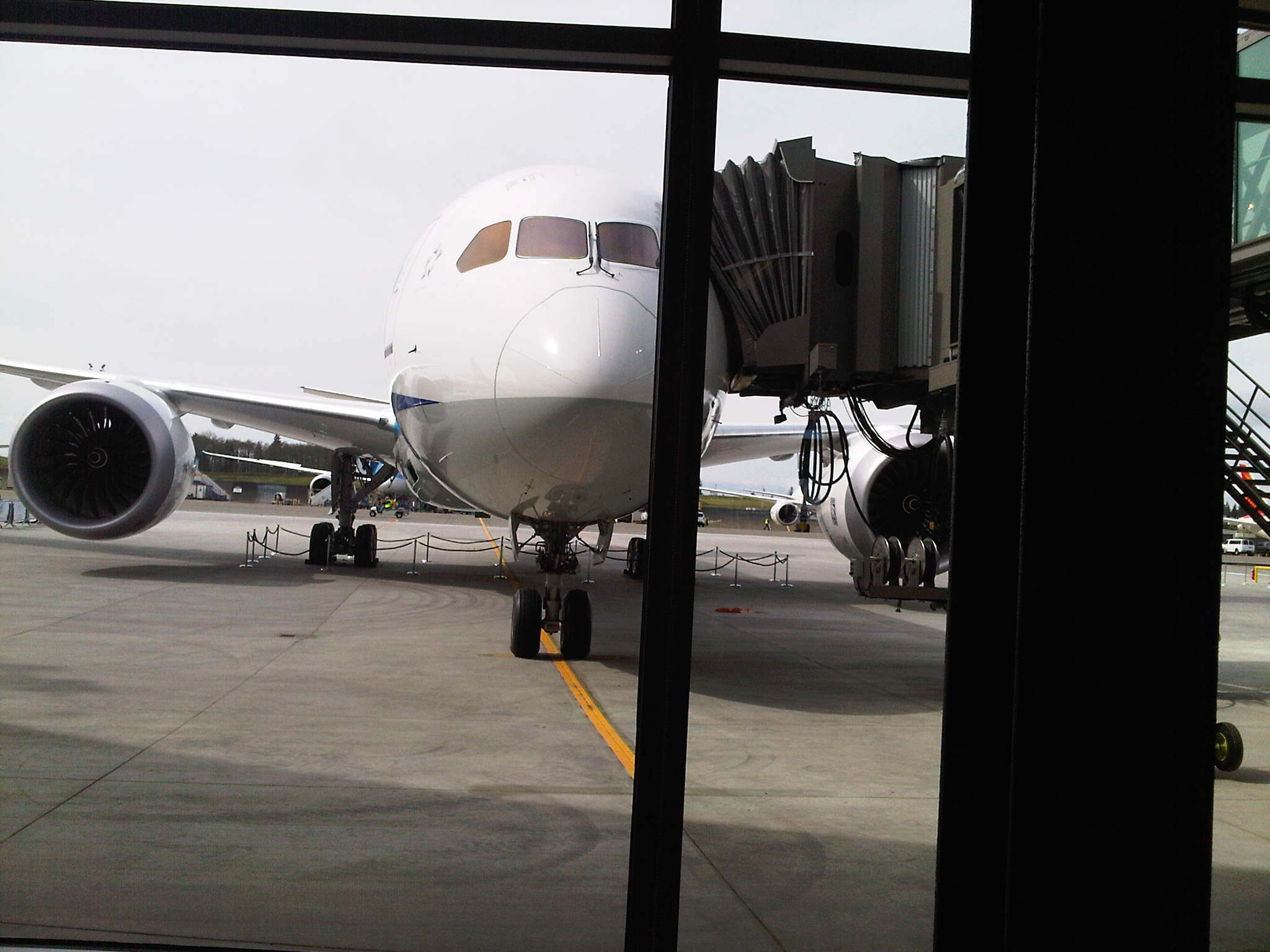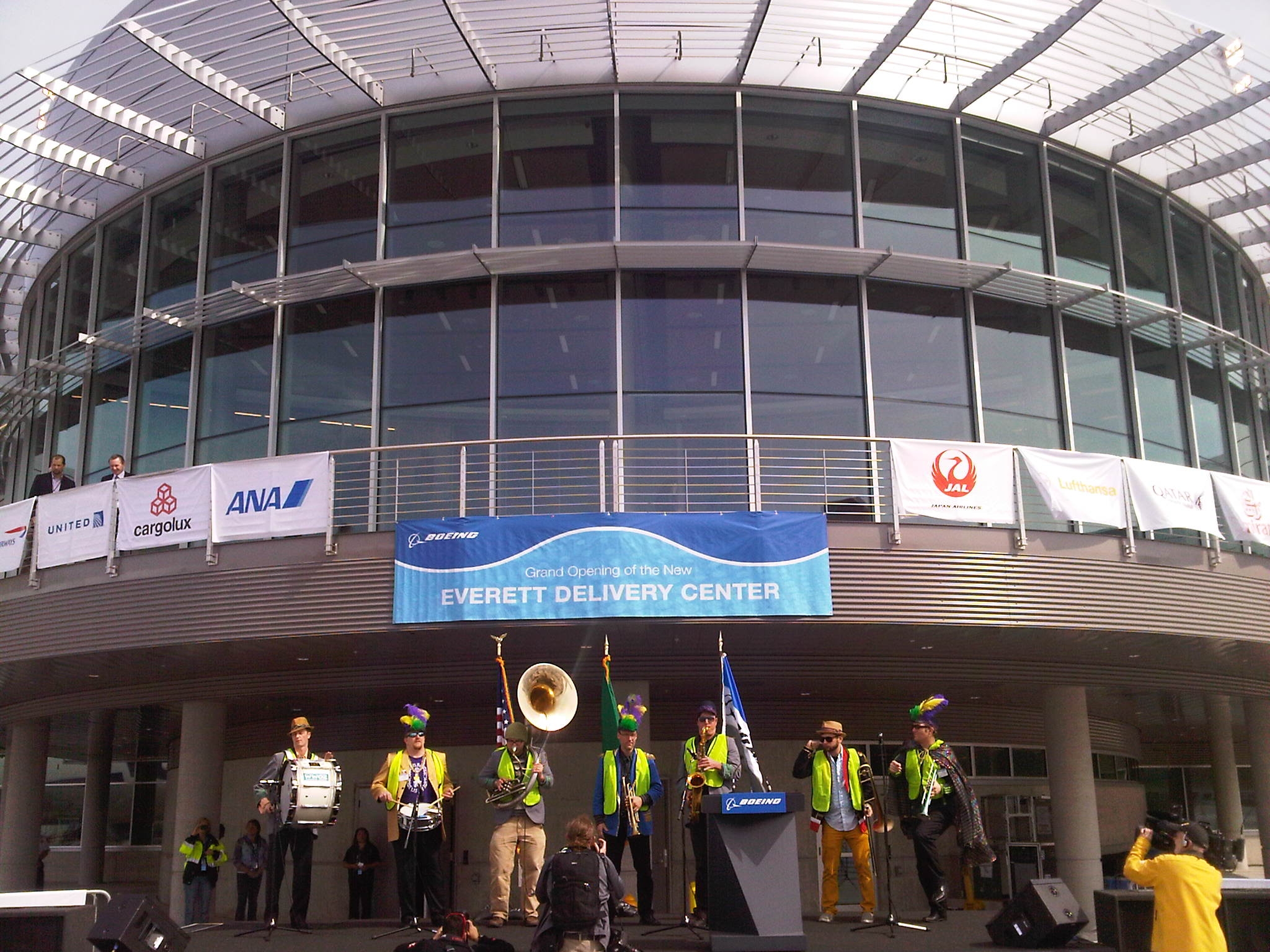Leeham News and Analysis
There's more to real news than a news release.
Boeing opens new Everett Delivery Center
Boeing today opened its new, 180,000sf delivery center at Everett Paine Field. The three-gate EDC is three times the size of the previous center that was roughly on the same site (the new EDC parking lot displaced the old center), and it’s a whiz-bang design that has high-tech “signing rooms,” entertainment areas and plenty of conference rooms and work stations.
And it has windows, something the old center basically lacked. The new center has a panoramic view of the KPAE flight line (which is filled with 787s and 747-8s right now).
ANA Boeing 787 at the new Everett Delivery Center, seen through the panoramic windows looking west. (Scott Hamilton photo.)
.
Deliveries were often effected at the Future of Flight Museum across the tarmac or at a temporary delivery center at the south end of KPAE.
Pat Shanahan, VP of Aircraft Programs for Boeing, noted that in 2010, Boeing Everett delivered 86 wide-body aircraft, followed by 105 in 2011 and 183 last year (a record). He expects another record to be set this year and still another next year.
The exterior of the new Boeing Everett Delivery Center is gun-metal grey, with sweeping airplane-like features inside and out. The band was but one of a group of international entertainers for the opening. (Scott Hamilton photo.)
.
Washington Gov. Jay Inslee, in remarks at the opening, vowed to “win” 777X production for the State at Everett. We asked Shanahan following the ceremony if the Everett facility has room for a seamless transition from the 777 current generation to the 777X; or whether something would have to be moved out of the plant, similar to shifting stuff around at Renton to make room for the 737 MAX; or whether production of one of the aircraft currently assembled at Everett would have to cease to make room. Shanahan, not surprisingly, dodged a direct answer and said only Boeing has “options.”
Boeing executive Pat Shanahan (left) and Washington Gov. Jay Inslee following the opening of the Everett Delivery Center at Paine Field. (Scott Hamilton photo.)
KC-46A progress toward summer milestones
Boeing’s KC-46A is moving ahead through milestones as summer approaches, despite being a the Sequestration “hit list” of programs that could be curtailed.
The USAF has previously said it wants to do all that it can to protect the program and the contract, seeking to avoid having to renegotiate the contract with Boeing.
Separately:
- The Puget Sound Business Journal has this article concerning the forthcoming NTSB hearing on the JAL 787 incident.
- US Airways now has echoed Delta Air Lines, saying Sequestration hurt March bookings and last minute travel.
- Buzz here in Seattle is that the 787 will fly another test flight today.
- UBS tracks Dreamlifter flights to gauge 787 production rates and notes that more flights than ever are now occurring. From this, UBS infers 787 production will ramp up according to plan.
Odds and Ends: ANA resumes 787 pilot training; Cash impact on 787; UAL, DAL miss profits; Mile High Club
ANA pilot training: ANA, the carrier with the largest fleet of Boeing 787s, has resumed pilot training for the aircraft, says Reuters. The article has a fair amount of detail about progress in the effort to return the 787 to service.
Cash impact of 787: UBS issued this note yesterday (April 1):
- See 787 as $6B cash drag in 2013: Even assuming battery issue is resolved and Boeing is able to hit its 787 delivery guidance at 60+, we still see 787 as a ~$6B cash drag in 2013 with ~$7B inventory build more than offsetting ~$1B advance draw. Our cash flow forecast assumes Boeing learns like it did on 777 and is worse than Boeing’s guidance for a similar 787 inventory build in 2013 as in 2012 ($5.7B).
- Cash drag could be much worse if battery issue lingers: As long as 787 remains grounded, Boeing is faced with the choice of either slowing production or building physical inventory. Every missed 787 deliveryrelative to Boeing’s >60 forecast adds $100-120M to our baseline forecast for a $6B 787 cash burn.
United, Delta miss profit forecasts: This isn’t good news: United Airlines and Delta Air Lines missed their first quarter profit targets on rising fuel costs. United’s profits have been hit-and-miss since the merger between legacy UAL and Continental Airlines. Delta has been more consistently profitable.
Next up, of course, is the union between American Airlines and US Airways. We’ll be going to the latter’s media day later this month, and obviously there will be much to talk about this year. CNBC has this profile on Doug Parker, the CEO of US Airways and the incoming CEO of the new American.
And finally: So much for the Mile High Club.
Odds and Ends: Finding the “root cause;” The cliche about bad pennies
Finding the “Root Cause:” The world waits for the Boeing 787 to return to service, following a series of proposed “fixes” designed by Boeing in conjunction with its relevant suppliers and with help from Ford, General Motors and other experts versed in lithium ion batteries.
The National Transportation Safety Board, investigation the Japan Air Lines battery fire in Boston, and the Japanese investigators trying to figure out the battery melt-down of the ANA battery in Japan, have yet to identify the root cause of the issues.
This disturbs many, who question the wisdom of prospectively returning the 787s to service without know the root cause. We confess we’re not too happy about this, either…the idea of an in-flight fire simply scares the bejesus out of us. (So does Boeing’s insistence no “fire” occurred, just two-inch flames in the JAL case and none at all with ANA. This simply is an eye-roller.)
But Sunday we were watching a program on the Smithsonian channel called Air Disaster. This program examines air accidents and near-accidents and this particular episode was called Turning Point, about Northwest Airlines flight 85 in 2002.
The flight was two hours west of Anchorage on its way to Tokyo (six hours away) when there was a rudder hard-over. Through superb airmanship, the flight returned to Anchorage and a one-shot emergency landing. The flight landed safely.
Investigators determined the Power Control Module (PCM) end cap blew out. The connecting rod went beyond the end of the PCM end cap and jammed the rudder. There was no apparent reason why the end cap blew out.
The long and the short of it: the NTSB could not find the root cause of what happened. But “stops” were added to the PCM to prevent the connecting rod from extending beyond the end cap location should another end cap blow out. Four years later, one did and the Air France 747-400F landed safely. Only then was it discovered that a design defect caused the failure.
This brings us to the 787. Many ask how the Federal Aviation Administration can clear the 787 to return to service without finding the root cause first. Boeing’s redesign has several elements to it, but to us the key one is the element intended to deny oxygen to the battery and thus snuff any fire before it can get started. Basic science tells us if there is no O2, there is no fire.
We recognize that many will say Boeing, its suppliers and the FAA should have designed this system in the first place. But as we have written on more than one occasion, aviation is replete with instances where testing was thought to be adequate only for later service to demonstrate through incident or worse that a flaw worked through the system. We’re just glad this flaw was discovered before any lives were lost or even any serious injuries occurred.
As for the prospect the FAA will allow the 787 to return to service but with ETOPS restrictions: we don’t see why restrictions should be imposed. When Reuters asked for our opinion about the prospect the FAA might restrict the 787 to only over-land flights, we said this would be very damaging and this is true. Since then there has been some speculation the ETOPS would be reduced from 180 minutes to 120 minutes. While this would be inconvenient, costly to airlines and still hurt the 787 business case, this is far less damaging than prospectively restricting the airplane to over-land flights.
Boeing said that it expects no restrictions (Mike Sinnett, 787 engineer, at the Tokyo press conference). Our view is rather pragmatic (or fatalistic, depending on your point of view). Given the information from Airbus in a 2012 fire-and-smoke study (totally unrelated to anything involving batteries or the 787) that a fire can go out of control in eight minutes and you need to land within 15, it doesn’t really matter whether ETOPS in 60, 90, 120, 180 or 330 minutes. If there is an airborne fire, chances are you’re cooked no matter what the ETOPS. (It also might be problematic for land within 15 minutes from a cruising altitude of 41,000 feet to an airport that could accommodate the 787 in any event.)
Note: we caution readers planning to comment on the above to watch yourselves. We’re clamping down on spurious and ill-considered tirades.
Bad Pennies: You know what they say about bad pennies always coming back. This couldn’t be more true with Scot Spencer, the convicted felon who keeps turning up in commercial aviation circles. We knew this guy when he and others purchased Braniff Inc (the second one) from the Hyatt family, ran this into the ground and bankrupted it, then started a third Braniff. Spencer and one of his co-investors went to jail for bankruptcy fraud.
Reputations of several respected airline officials Spencer and his co-investors hired to run Braniff Inc were damaged by their association with Spencer. We then wrote for trade magazine Airfinance Journal and revealed a scheme called upstreaming from a series of aircraft leases whereby Spencer and his co-investors bumped the lease rates they paid to higher rates subleased to Braniff, adding tens of thousands of dollars per month to Boeing 737s leased to the carrier through a separate company owned by Spencer and his co-investors. Once this was revealed, a $100m financing was withdrawn prior to closing. Braniff Inc ceased operations a few months later.
The Department of Transportation banned Spencer from future airline involvement, so he went to San Bernardino (CA) and in a move that still baffles us, persuaded elected officials there to give him millions of dollars in contracts to develop the former Norton AFB into a commercial airport. The project was silly to begin with–the Ontario Airport is just down the road–but even knowing Spencer was a convicted felon didn’t dissuade these stupid officials from giving Spencer contracts.
This story, complete with photo of Spencer in custody and hiding his handcuffs, has links to several other stories.
This old document has some of the sordid history of Spencer’s involvement with Braniff.
Here is a court record of Spencer’s bankruptcy fraud.
McNerney on unions and other stuff; where will 777X be built?
Note to Readers wishing to comment: See this article and our Comment #35 and be forewarned.
Boeing CEO Jim McNerney is cited in the Puget Sound Business Journal on labor unions, China and other stuff from his appearance at an aerospace summit.
In the article, McNerney tries to take a moderate stance on unions. But just this week Boeing announced it is moving SPEEA and other union jobs out of Puget Sound, here and here. The moves resulted in a blast from Seattle Times columnist Jon Talton here, and our response here.
Production is booming in Seattle’s Puget Sound, but it’s clear to us that Boeing is engaged in a long-term strategy to build up Charleston as a major, second production plant–not just a 787 production line. We see Charleston-as-to-Seattle as Hamburg-is-to-Toulouse some day. We don’t see Everett shutting down (at least not in our lifetime) because there is too much there. We think Renton is more at risk, once there is a New Small Airplane finally designed to replace the 737–but this is well into the next decade.
The question over where the 777X will be be built is, to us, a little more vexing. Logic says build it here, given the similarities between the baseline 777 and the derivative 777X. This is no different in principal than the 737NG and the 737 MAX–it would have been silly to build it elsewhere.
But McNerney’s comments about labor in the Business Journal notwithstanding, the anti-union sentiment at Boeing Corporate is obvious for all to see.
The future of the 747-8 is in jeopardy. Boeing said as much in its 2012 10K:
Flaws escape FAA certification
Bloomberg has a good story looking beyond the Boeing 787 issues at the FAA’s reliance on industry to certify airplanes. The story details a number of cases where flaws crept through the system, leading to deaths–a circumstance, of course, that did not happen with the 787.
We have written a couple of posts about the relationship between the FAA and industry in response to focus following the 787 battery issues. We pointed out this relationship is nothing new.
The Bloomberg piece is well worth reading.
Reuters: 787 ETOPS threatened in resumption of service
Reuters reports that the Boeing 787’s ETOPS certification may be questionable when the FAA authorizes a return to service.
787 test flight plan filed for today
From Boeing:
We have just filed a flight plan to conduct a 787 functional check flight today on Line number 86, a Boeing-owned production airplane built for LOT Polish Airlines.
The flight plan (which is always subject to change) can be viewed via FlightAware, which can also be used to track the airplane’s route, location and progress throughout the flight, at this link: http://flightaware.com/live/flight/BOE272
The flight is a normal Boeing production check flight intended to validate that all systems function as designed. During a functional check flight, crews cycle the landing gear and operate all the backup systems, in addition to performing electrical system checks from the flight profile. Across airplane programs, more than 600 functional check flights were completed in 2012.
Following the completion of the functional check flight, we will analyze the data from the flight and prepare for certification ground and flight demonstration in the coming days. The plan is to conduct one certification demonstration flight. That flight, which will take plan on Line 86, will demonstrate that the new battery system performs as intended during flight conditions.
The flight will take off and land at Paine Field in Everett, Wash. The flight is currently scheduled to depart at approx. 11:00 am Pacific time, but is subject to change. The flight is expected to be approximately 2 hours in length.
For those media located in the Puget Sound area, Boeing will not be providing access to the airplane or our facilities before or after the flight. The Future of Flight has reserved its rooftop deck for use by media as a viewing location for photos and video of the airplane’s takeoff and landing.
We plan to provide updates and photos via Twitter (@BoeingAirplanes) and will send a brief media statement via e-mail after the flight is completed.





